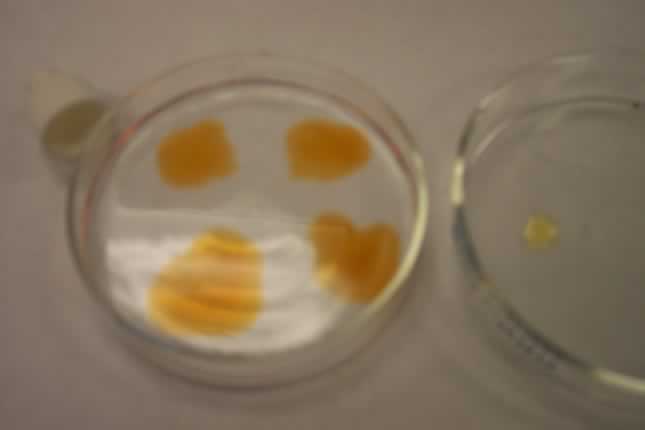Instrumentation
- Teacher's Guide
SED 695B; Fall 2005
SED 695B; Fall 2005
Overview:
A colorless solution is turned dark orange with the addition of a liquid, then the addition of a solid. The dark orange disappears with the addition yet another solid, but appears again with the addition of the original liquid and/or solid.


Materials:
- Potassium Thiocyanate Solution
- Potassium Thiocyanate Crystals
- Ferric Nitrate Solution
- Potassium thiocyanate
- Sodium phosphate, monobasic
- 50 mL Graduated Cylinder
- Petri Dish
- Spatulas, two
- Overhead Projector
- Chemical Resistant gloves, apron and splash goggles

Topics addressed:
Experiment
- Chemical Equilibrium
- Complex Ions
- Add about 20 mL of potassium thiocyanate solution into a petri dish. Place this on an overhead.
- With the overhead on, add a drop of ferric nitrate to an empty petri dish (for later comparison) and four drops to the solution. See above picture. Note the color is darker than the drop without Potassium Thiocyanate Solution.
- Swirl the solution to obtain a consistent orange color. See figure 1.
- Add a very small amount (about 1/2 the size of a pea) of Potassium Thiocyanate Crystals in the middle of the Petri Dish. A dark orange spot will form, and spread. Observe this spreading effect.
- Again, swirl the solution to obtain a uniform color. See figure 2.
- Add 1/4 pea size amount of the sodium phosphate monobasic crystals in one spot. Again observe the color change (it should be getting lighter).
- Swirl until colorless See figure 3.
- To observe the colors yet again, add one drop of ferric nitrate solution to one side of the beaker and a small amount of potassium thiocyanate crystals to a different spot. Observe the color changes with the different chemicals. See figures 4 and 5.
Chemical Concepts:
 and
and  form the complex ion
form the complex ion  .
.- Increasing the concentration of a reactant ion shifts the equilibrium toward the products (LeChatlier's Principle)
- An equilibrium reaction is proceeding both directions at all times.
Key Reactions:
(Orange + Colorless
become red-orange)
(Orange
+ Colorless become colorless)
Notice in the above reactions that the ![]() ion is tied up with the
addition of
ion is tied up with the
addition of ![]() , not allowing it to form the complex ion
, not allowing it to form the complex ion ![]() .
.





References & Links:
An explanation of Chemical Equilibrium and Le Chatlier's Principle
A Discussion of Complex Ions